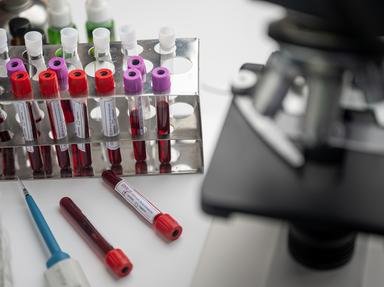Quiz Answer Key and Fun Facts
1. In the beginning, it was believed that proteins were rigid entities which bound substrates that fitted perfectly into their binding pockets. This idea of shape complementarity is called the Lock and Key Hypothesis. Which person is credited with developing this theory?
2. Weaknesses in the Lock and Key Hypothesis began to emerge as more work was done. For example, it fails to explain the ability of molecules to bind to proteins and influence the protein's ability to bind other substrates. What name is given to this phenomenon?
3. Improved understanding of protein mechanisms showed that proteins are not rigid, and that large domain movements can be seen in some proteins. One example is a protein known to be activated by calcium. Upon binding calcium ions, this 148 amino acid protein undergoes a large conformational change to reveal two hydrophobic protein binding sites. Which protein is this?
4. Koshland's Induced Fit Hypothesis came to replace the Lock and Key Hypothesis as the favoured theory of protein binding. Which of the following best describes the Induced Fit Hypothesis?
5. As analytical methods became more advanced, it became clear that proteins were more dynamic than anyone had first thought. These protein motions occur over a wide range of timescales. Which of the following protein motions is incorrectly matched with the timescale over which it usually occurs?
6. Dynamics are essential to protein function, and it is therefore important to ensure that proteins are not too stable. To do this, proteins have to finely balance which two thermodynamic quantities?
7. The most dynamic areas of proteins are usually those involved in binding other components. Upon binding, however, the binding region becomes less dynamic. Which of these is least likely to contribute to the stability of the protein-substrate interaction?
8. In opposition to the Induced Fit hypothesis, some believe that the active conformation already exists in solution, and that substrate molecules merely select this conformation. Upon binding, there is a shift in the equilibrium of the protein dynamics to favour this active conformation. What is this rival theory of protein binding known as?
9. If it is true that active protein conformations can exist in solution in the absence of other molecules, it should be possible to observe these active conformations in a solution of just the protein. Does this happen?
10. Considering examples such as immunoglobulin E, dihydrofolate reductase, and even haemoglobin, protein binding can often be seen as a combination of there being pre-existing active conformers, while still obeying the Induced Fit Hypothesis.
Source: Author
doublemm
This quiz was reviewed by FunTrivia editor
WesleyCrusher before going online.
Any errors found in FunTrivia content are routinely corrected through our feedback system.
